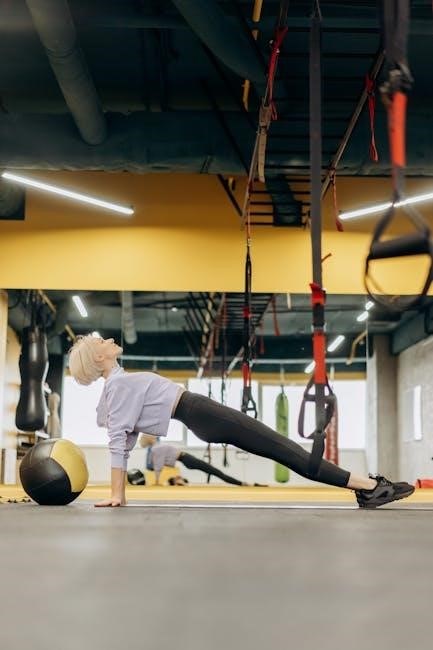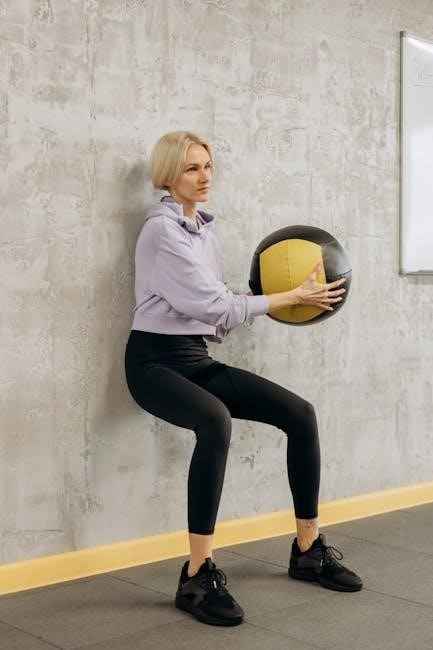Shoulder stability exercises are essential for enhancing strength, balance, and mobility․ They target key muscles, improving posture and reducing injury risk, especially for athletes and individuals with shoulder instability․
1․1 Importance of Shoulder Stability
Shoulder stability is crucial for maintaining proper joint function and preventing injuries․ The shoulder is a highly mobile joint, making it prone to instability and dislocations․ Weak or imbalanced muscles around the shoulder can lead to poor posture, reduced range of motion, and chronic pain․ Strengthening the stabilizing muscles, such as the rotator cuff, improves joint integrity and enhances athletic performance․ Additionally, shoulder stability exercises promote better alignment, reducing the risk of long-term damage․ For individuals with shoulder instability or post-injury rehabilitation, these exercises are essential to restore function and confidence․ Even for those without specific shoulder issues, incorporating stability exercises into a workout routine can improve overall upper body mechanics and reduce the likelihood of future problems․ In essence, shoulder stability forms the foundation for effective and pain-free movement in daily activities and sports․
1․2 Benefits of Shoulder Stability Exercises
Engaging in shoulder stability exercises offers numerous benefits, including enhanced joint integrity and reduced injury risk․ These exercises strengthen the rotator cuff and surrounding muscles, improving posture and alleviating chronic pain․ For athletes, they boost performance by optimizing movement mechanics and preventing dislocations․ Rehabilitation after shoulder injuries also benefits from these exercises, restoring function and confidence․ Additionally, they promote better alignment, reducing long-term damage risk․ Incorporating them into daily routines enhances upper body mechanics, minimizing future issues․ Overall, shoulder stability exercises are vital for effective, pain-free movement in both daily life and sports․

Understanding Shoulder Anatomy for Stability
The shoulder’s complex anatomy includes muscles, ligaments, and bones that work together for stability․ The rotator cuff is crucial, providing a stable base for movement, while the scapula supports the humerus․
2․1 Major Shoulder Muscles and Their Roles
The shoulder joint is supported by several key muscles, each playing a distinct role in stability and movement․ The deltoid muscle is responsible for abduction, flexion, and extension of the arm, while the rotator cuff muscles—supraspinatus, infraspinatus, teres minor, and subscapularis—stabilize the humerus within the glenoid cavity․ The supraspinatus prevents downward displacement, the infraspinatus and teres minor assist in external rotation, and the subscapularis aids in internal rotation; Additionally, the trapezius and serratus anterior muscles contribute to scapular stabilization, ensuring proper movement and preventing misalignment․ Understanding these muscles’ functions is vital for designing effective shoulder stability exercises that target each muscle group appropriately, promoting overall shoulder health and functionality․
2․2 The Role of the Rotator Cuff in Stability
The rotator cuff is a group of four muscles—supraspinatus, infraspinatus, teres minor, and subscapularis—that play a critical role in shoulder stability․ These muscles work together to keep the humerus securely positioned within the glenoid cavity, allowing for smooth and controlled movement․ The supraspinatus prevents downward displacement of the humerus, while the infraspinatus and teres minor assist in external rotation and stabilization․ The subscapularis contributes to internal rotation and helps maintain proper alignment․ Collectively, the rotator cuff muscles provide dynamic stability, enabling the shoulder to function effectively during various activities․ Strengthening these muscles through targeted exercises is essential for preventing injuries, improving joint integrity, and enhancing overall shoulder function․ Weakness or imbalances in the rotator cuff can lead to instability, pain, and reduced mobility, making it a key focus in shoulder stability training programs․

Best Exercises for Shoulder Stability
Effective shoulder stability exercises include bird dogs, shoulder bridges, and wall slides․ These movements target the rotator cuff and scapular stabilizers, enhancing control and reducing injury risk․
3․1 Beginner-Friendly Shoulder Stability Exercises
For those new to shoulder stability training, exercises like shoulder shrugs, wall slides, and seated forward folds are excellent starting points․ These movements gently engage the rotator cuff and scapular stabilizers, improving posture and reducing tension․ Wall slides, in particular, help strengthen the muscles without putting excessive strain on the joints․ Another effective exercise is the bird dog, which enhances core stability while targeting the shoulders․ These exercises are low-impact and can be performed at home, making them ideal for beginners․ Proper form is crucial to avoid injury, so starting with slow, controlled movements is recommended․ Progressing gradually ensures the muscles develop strength and endurance over time;
3․2 Intermediate Shoulder Stability Exercises
Intermediate shoulder stability exercises build on foundational movements, incorporating resistance and dynamic control․ Resistance band exercises, such as external rotations and shoulder presses, are effective for strengthening the rotator cuff and scapular stabilizers․ Dumbbell shoulder stabilizations, where you hold a light weight while maintaining proper posture, enhance endurance and balance․ Plank variations, like shoulder taps and lateral shifts, challenge core stability while engaging the shoulders․ Progressing to single-arm exercises, such as single-arm wall slides, increases difficulty by isolating muscle groups․ These exercises improve joint stability and reduce the risk of injury․ Incorporating isometric holds, such as the overhead shoulder stabilization exercise, further strengthens the muscles․ Consistency and proper form are key to advancing safely and effectively in intermediate-level training, ensuring continued progress in shoulder stability and overall upper body strength․
3․3 Advanced Shoulder Stability Exercises
Advanced shoulder stability exercises are designed for individuals with a strong foundation in intermediate training․ These exercises challenge the shoulders dynamically, enhancing strength, control, and resilience․ Single-arm inverted rows with rotational components test stability while building power․ Medicine ball throws and catches require precise shoulder and core coordination․ Dynamic overhead holds with resistance bands or light weights push endurance and control․ Functional exercises like the Turkish get-up integrate shoulder stability with full-body movement․ Incorporating plyometric elements, such as explosive push-ups or clapping pushaways, adds intensity․ Advanced training also involves unstable surfaces, like BOSU ball shoulder stabilizations, to mimic real-world challenges․ Progression to weighted rotational exercises, such as cable rotations and lateral raises with isometric holds, further strengthens the rotator cuff and scapular muscles․ These exercises prepare the shoulders for high-level performance, ensuring durability and adaptability in demanding physical activities․

Creating a Shoulder Stability Workout Plan
A well-structured shoulder stability workout plan balances strength, mobility, and functional movements․ Incorporate exercises progressively, ensuring proper form and consistency to build resilience and prevent injuries over time effectively․
4․1 Structuring a Full Shoulder Workout Routine
A comprehensive shoulder workout routine should focus on stability, strength, and mobility․ Begin with a dynamic warm-up to prepare the muscles․ Incorporate foundational exercises like shoulder blade squeezes and wall slides to improve posture and reduce injury risk․ Progress to strengthening exercises such as lateral raises, front raises, and reverse flys to target the deltoids and rotator cuff muscles․ Include functional movements like push-ups and overhead presses to enhance overall shoulder stability․ Finish with static stretches to improve flexibility․ Aim for 2-3 sets of 8-12 repetitions for strength exercises and 20-30 seconds per stretch․ Ensure proper form throughout and adjust weights or resistance based on fitness level․ Consistency is key to building resilience and maintaining healthy shoulders over time․ Always consult a professional to tailor the routine to individual needs and goals․
4․2 Incorporating Stability Exercises into Daily Routines
Incorporating shoulder stability exercises into daily routines can be simple and effective․ Start by dedicating 5-10 minutes each day to foundational movements like shoulder blade squeezes, wall slides, and arm circles․ These exercises can be done during breaks at work or while waiting in line․ For those with busy schedules, integrate stability work into existing routines, such as pairing shoulder stretches with morning yoga or adding rotator cuff exercises to a post-workout cool-down․ Consistency is key; even brief, regular practice can improve posture, reduce injury risk, and enhance overall shoulder health․ Over time, these small habits can become second nature, contributing to long-term stability and resilience․ Always prioritize proper form and adjust exercises based on comfort and fitness level to ensure safe and effective progression․

Progression and Variation in Shoulder Exercises
Progression and variation are crucial for continuous improvement in shoulder stability․ Start with basic exercises and gradually increase difficulty by adding resistance or dynamic movements․ Incorporate variations like single-arm exercises or unstable surfaces to challenge stability further and prevent plateaus․
5․1 Increasing Difficulty in Stability Exercises
Incorporating progressive overload is key to advancing shoulder stability․ Start with bodyweight exercises like wall slides or arm circles, then gradually add resistance using bands or light dumbbells․ Introduce dynamic movements, such as single-arm lateral raises or rotational exercises, to challenge control․ Unstable surfaces, like a balance board or foam pad, can enhance proprioception․ For advanced trainees, increase range of motion or speed while maintaining proper form․ Periodically reassess and adjust exercises to ensure continuous improvement․ Varying grips, angles, or tempos can also keep workouts engaging and effective․ By systematically increasing difficulty, individuals can build resilience and achieve long-term shoulder health․
5․2 Avoiding Plateaus in Shoulder Training

Avoiding plateaus in shoulder training requires consistent variation and progression․ Incorporate diverse exercises targeting different muscle groups, such as the rotator cuff, deltoids, and scapular stabilizers․ Alternate between isolation and compound movements to keep workouts dynamic․ Gradually increase resistance, reps, or sets over time to challenge muscles․ Introduce new equipment, like resistance bands or cables, to vary the stimulus․ Incorporate plyometric or functional exercises to enhance power and coordination․ Periodically change your training frequency or volume to prevent adaptation․ Focus on perfect form and mind-muscle connection to maximize efficiency․ Incorporating recovery techniques, such as stretching and foam rolling, can also optimize progress․ By continuously evolving your routine and staying consistent, you can overcome plateaus and achieve sustained shoulder development and stability․

Recovery and Safety in Shoulder Stability Training
Proper recovery and safety are crucial for effective shoulder stability training․ Ensure adequate rest, use stretching, and monitor pain levels․ Modify exercises as needed to prevent injury and promote healing․
6․1 Importance of Rest and Recovery
Rest and recovery are vital components of any effective shoulder stability training program․ Allowing your muscles and joints time to heal prevents overtraining and reduces the risk of injury․ During rest, your body repairs and strengthens the muscles, tendons, and ligaments, enhancing overall stability and function․ Neglecting recovery can lead to fatigue, decreased performance, and prolonged pain․ Incorporate rest days or active recovery, such as light stretching or low-intensity activities, to promote healing․ Additionally, ensuring adequate sleep and proper nutrition supports muscle repair and growth․ Listening to your body and avoiding exercises that cause pain is essential to maintain long-term shoulder health and stability․ Consistent rest and recovery practices not only improve exercise outcomes but also enhance overall well-being and mobility․
6․2 When to Stop or Modify Exercises
It’s crucial to recognize when to stop or modify shoulder stability exercises to avoid further injury or aggravation․ If you experience sharp pain, numbness, or tingling during or after an exercise, discontinue it immediately․ Persistent discomfort or swelling around the shoulder joint is a sign to seek professional guidance․ Modifications may be necessary if certain movements exacerbate existing conditions or limitations․ For instance, substituting a plank variation for a traditional plank can reduce strain on the shoulders․ Consulting a physiotherapist or trainer ensures exercises are tailored to your specific needs and abilities․ Ignoring warning signs can lead to prolonged recovery or chronic issues․ Prioritizing safety and adjusting routines as needed is essential for effective and sustainable shoulder stability training․ Always opt for controlled, pain-free movements to protect your shoulders and maintain progress in your fitness journey․
